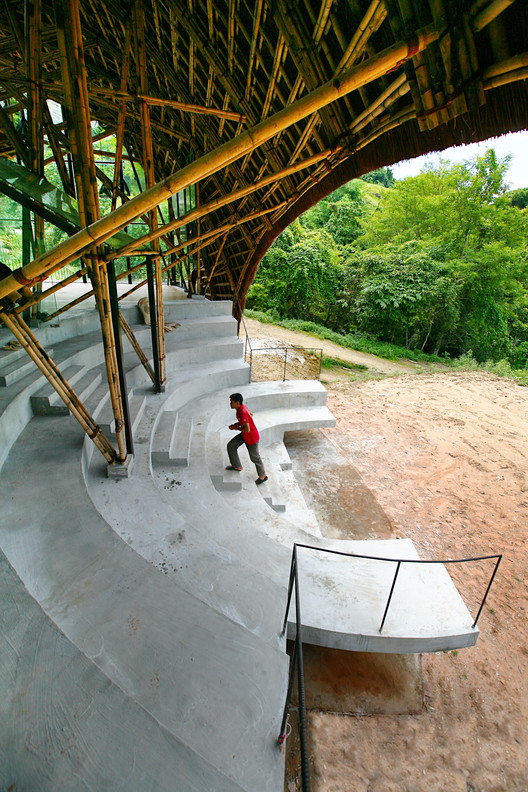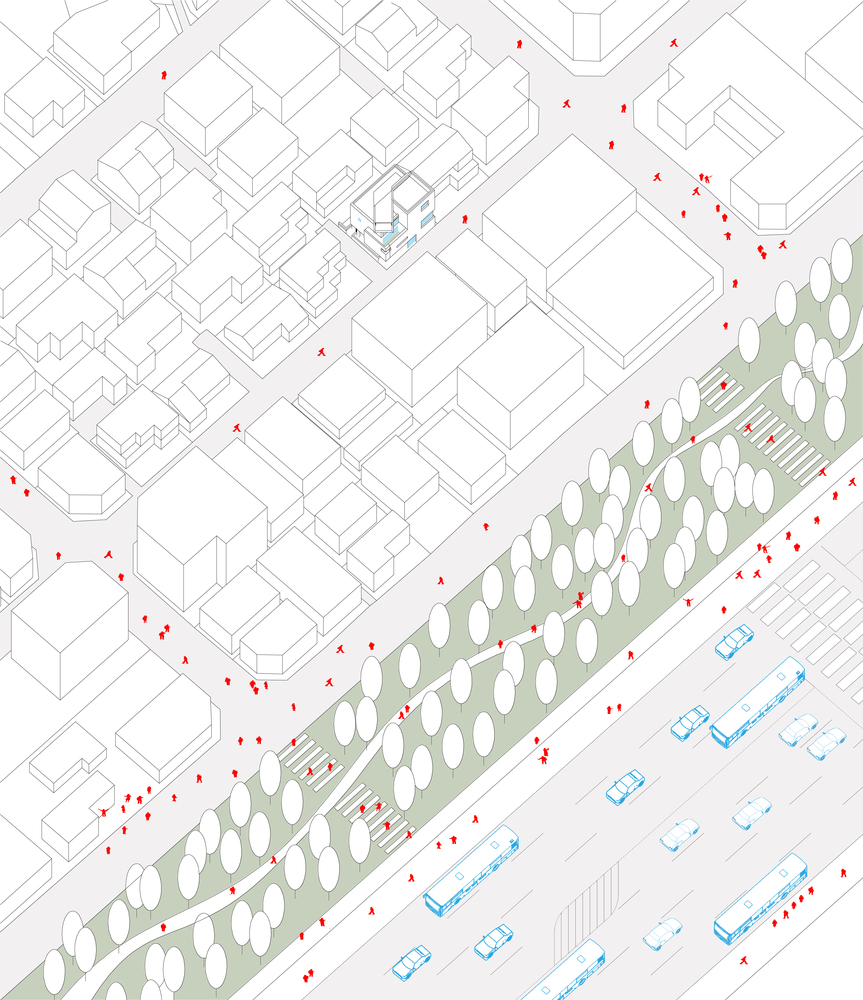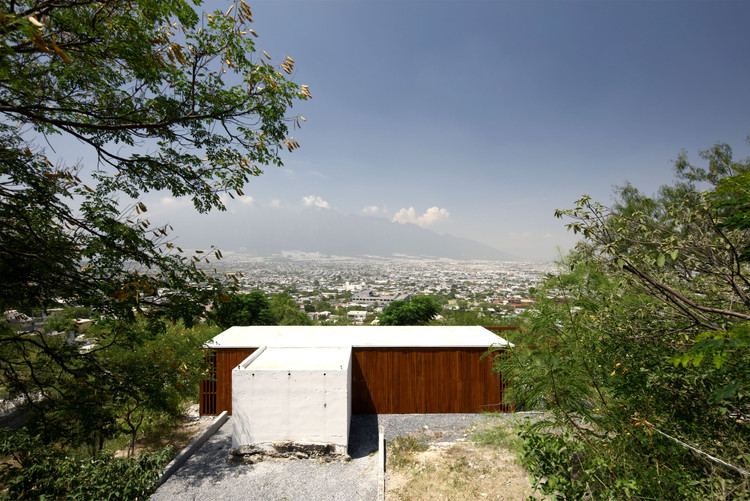OB Houses Seijo Peon Arquitectos
2013-01-18 00:00
架构师提供的文本描述。这对夫妇有四个女儿,他们希望在一个23米的海滨地段为他们所有人建造一座海滨别墅。他们最初的想法是有一个海滨主楼,后面有三个相邻的平房,所以在这种方法下,只有主房子才能看到大海的正面景色,而平房则不会。尤其重要的是,即使今天没有隔壁邻居建造他们的海滨别墅,这种情况在不久的将来也可能发生。该方案需要四个社会区域及其各自的服务和10间卧室(4间在主楼,2间在平房内)。此外,还需要共享服务和支助领域。
Text description provided by the architects. The clients, a couple with four daughters, wished to have a beach house for all of them, in a 23 meter beach-front lot. Their original idea was to have a seafront main house and three adjoining bungalows in back, so in this approach, only the main house would have frontal views to the ocean, and the bungalows wouldn’t. This is especially important taking in regard that even if today no next-door neighbors have built their beach houses, it could happen in any time in the near future. The program required four social areas with their respective services and 10 bedrooms (4 in the main house and two per bungalow). In addition there was a requirement of a shared service and support area.
© Tamara Uribe Manzanilla
(Tamara Uribe Manzanilla)
广泛的程序和丰富的自然环境是设计分析过程的主要动机。我们的努力被应用于一项主要的初步任务,这是我们的客户无法预见的,而且以一种相当雄心勃勃的方式:让每个房子都能直接看到海洋,考虑到只有对角线对海洋的看法不会割断它,因为邻居将来可以建造,海景也会受到损害。遵循这一理想,我们接受了设计的挑战,以便每个卧室和社会区域都能享受海景,甚至考虑到未来潜在的周边建筑。在现时无人居住的地块内完成对角线海景,在设计上并不复杂,但由于日后的楼宇可能会阻碍我们的意见,所以我们进行了更复杂的设计工作,就是透过客户直接到海解决所有的意见。
The extensive program and rich natural environment were the main motivations of the design analysis process. Our efforts were applied to one main initial task which was unforeseen by our clients and in a way quite ambitious: Giving each house a frontal direct view to the sea, taking in regard that only diagonal views to the ocean would not cut it, as the neighbors could build in the future and the ocean views would be compromised. Following this ideal, we took the challenge of designing in order that each bedroom and social area could enjoy an ocean view, considering even the future potential surrounding constructions. Accomplishing diagonal views to the sea through the now uninhabited side lots were not that complex in terms of design, but as the views would probably be obstructed by future buildings, we engaged in the much more complicated design task of resolving all views thru our clients lot directly to the sea.
这项工作的开始是安排每栋房子通过想象中的西北至东南轴线,这样的方式,每所房子至少有一些海景,并利用盛行的风。在这个系统中,每个房子都被要求将其程序的一部分与它前面的房子重叠,这样部分的立面就会被前面的房子的背面所面对。使用传统的正交体积,海景将遇到一个非常咄咄逼人的墙,垂直于主轴视图。
The work was begun by arranging each house through an imaginary Northwest to Southeast axis in such a way as every house had at least some ocean view and taking advantage of the prevailing winds. In this system, each house was required to overlap a portion of its program with the house immediately in front of it, so that part of the façade would be confronted by the back-side of the house in front. Using conventionally orthogonal volumes, the view to the ocean would be met with a very aggressive wall, perpendicular to the main axis view.
© Tamara Uribe Manzanilla
(Tamara Uribe Manzanilla)
从那时起,我们遵循这样的想法:在每栋房子的东侧延伸处用非常流畅的弧形线工作,这样,来自每个社交区和卧室的景色就会慢慢滑向海洋…。这种方法最大限度地提高了向海洋的空间流动性。每个主卧室都有一个通向大海的主要前部,而曲线之间的重叠为其他房间提供了视觉效果。
From that point we followed the idea of working with very fluid curved lines on the eastern extension of each house, so the views from each social area and bedroom would slide gently towards the ocean… spatial fluidity towards the ocean was maximized be this approach. Each main bedroom has a major front to the sea, and the overlapping between curves generates visuals for the other rooms.
© Tamara Uribe Manzanilla
(Tamara Uribe Manzanilla)
在西侧,曲线也被设计成轻轻的通向海边的走廊/露台,作为通往每个平房的通道。进入主房子的通道被放置在外部布局中非常清晰的视觉轴的末端。这些梯田也作为风洞,产生新鲜感的主要社会领域的每所房子。较小的曲线和混凝土板被放置在不同的高度,以重定向和利用气流,因此每个室内空间都有一个自然风流,这在热带地区是非常方便的。此外,曲线的设计是为了提供社会领域之间的隐私。
On the west side, curves were also designed to gently lead to porches/terraces facing the sea that serve as access to each bungalow. The access to the main house is placed at the end of a very clear visual axis in the exterior layout. These terraces also serve as wind tunnels that generate freshness to the main social area of each house. Smaller curves and concrete slabs are placed at different heights to redirect and take advantage of air currents so every interior space has a natural wind flow which is very convenient of course in the tropics. Also the curves were designed to provide privacy between social areas.
© Tamara Uribe Manzanilla
(Tamara Uribe Manzanilla)
正式语言在当地社区中产生了几种解释,涉及可能从一开始就激发设计灵感的上下文元素(波浪、帆、贝壳、沙丘、船)…。事实上,曲线设计的起源是对海洋进行广泛的空间和视觉分析的结果。当然,在设计过程中,人们认识到了与上下文元素的相似之处,并将其与周围环境联系起来。
The formal language has generated several interpretations among the local community regarding the contextual elements that may have inspired the design from the beginning (waves, sails, shells, dunes, boats)… The truth is that the origin of the curvilinear design was the result of an extensive spatial and visual analysis towards the sea. Of course during the design process the similarities with contextual elements were acknowledged and exploded to relate the project to its surroundings.
 举报
举报
别默默的看了,快登录帮我评论一下吧!:)
注册
登录
更多评论
相关文章
-

描边风设计中,最容易犯的8种问题分析
2018年走过了四分之一,LOGO设计趋势也清晰了LOGO设计
-

描边风设计中,最容易犯的8种问题分析
2018年走过了四分之一,LOGO设计趋势也清晰了LOGO设计
-

描边风设计中,最容易犯的8种问题分析
2018年走过了四分之一,LOGO设计趋势也清晰了LOGO设计








































































































